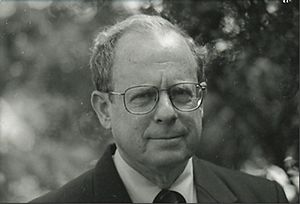Jeremy Stone facts for kids
Quick facts for kids
Jeremy Stone
|
|
|---|---|
 |
|
| Born | November 23, 1935 |
| Died | January 1, 2017 (aged 81) |
Jeremy J. Stone (born November 23, 1935 – died January 1, 2017) was an American scientist. He was the leader of the Federation of American Scientists (FAS) for 30 years, from 1970 to 2000. At FAS, he worked on important issues like controlling weapons, protecting human rights, and shaping how America dealt with other countries. After leaving FAS, he continued his work at a new group called Catalytic Diplomacy. Jeremy Stone was the son of a famous journalist, I. F. Stone.
Early Life and Education
Jeremy Stone was born in 1935. He went to the Bronx High School of Science from 1951 to 1953. During this time, he even taught Three-dimensional chess at the New School for Social Research.
College and Early Research
After studying for a year at MIT, he graduated from Swarthmore College in June 1957. In the summer of 1958, while working as a consultant for the RAND Corporation, he created a new method for solving math problems called the Cross-Section Method of Linear Programming.
Advanced Studies
Stone earned his Ph.D. in mathematics from Stanford University in 1960. He then joined the Stanford Research Institute (SRI) as a research mathematician. There, he worked on "Error Correcting Codes," which are ways to find and fix mistakes in data. In 1962, he left SRI to focus on important topics like war and peace at the Hudson Institute.
Career and Advocacy
In 1963, Jeremy Stone started working on a plan to control weapons. He wanted to prevent the creation of anti-ballistic missile (ABM) systems, which are designed to shoot down enemy missiles.
Arms Control Efforts
From 1964 to 1966, he was a researcher at the Harvard Center for International Affairs. During this time, he wrote two books about controlling weapons. He also taught mathematics and arms control at Pomona College from 1966 to 1968.
Leading the Federation of American Scientists
In June 1970, Stone became the CEO of the Federation of American Scientists (FAS). This organization was started in 1945 by atomic scientists. Because he often spoke out against spending by the Pentagon, his name appeared on a list of "enemies" of President Nixon in June 1973.
Key Contributions at FAS
During his 30 years leading FAS, Jeremy Stone helped shape many important discussions. These included:
- The nuclear arms race: trying to stop countries from building too many nuclear weapons.
- Human rights: protecting the basic rights of people around the world.
- Ethnic violence and civil conflict: working to reduce fighting between different groups.
- Controlling dangerous weapons: trying to limit biological and chemical weapons.
- Energy and environment: discussing energy saving and global warming.
Successful Initiatives
Many of Stone's ideas for controlling weapons were successful. For example, the ABM Treaty was sometimes called "Jeremy Stone's proposal" by the Russians as early as 1967. He also helped get the Carter Administration to approve a follow-up plan to the SALT II agreement. He even came up with a clever idea called the "Bear Hug Strategy" that might have helped make the START II treaty possible.
Promoting Scientific Exchange and Human Rights
In the 1970s, Stone and FAS helped open up scientific discussions with China in 1972. He also convinced American scientists to create committees to protect the rights of Russian scientists. He was a strong supporter of the Soviet physicist Andrei Sakharov, who called Stone "creative, articulate and brave" in 1976.
Other Important Work
Stone played a key role in stopping an illegal U.S. Government program where the CIA was opening mail. He also helped change U.S. policy on Cambodia when the U.S. was allied with the Khmer Rouge, a group responsible for terrible acts. He even worked to get the CIA and the KGB (the Soviet intelligence agency) to cooperate on shared concerns.
Memoirs and International Relations
In April 1999, Stone published his memoir, "Every Man Should Try": Adventures of a Public Interest Activist. This book shared his successes and challenges. He also led the first American scientific group to Iran in 20 years in December 1998. In September 1999, he hosted a return visit from the Academy of Sciences of Iran. This led to an agreement to restart scientific exchanges between Iran and the U.S.
Stone published his second memoir, Catalytic Diplomacy: Russia, China, North Korea, and Iran, in October 2009. It covered his work from 1999 to 2006.
Later Work and Recognition
After leaving the Federation of American Scientists on June 1, 2000, Jeremy Stone started a small nonprofit group called Catalytic Diplomacy. From 1999 to 2006, this group mainly worked on relations between China and Taiwan, U.S.-Russian arms control, and U.S. relations with Iran and North Korea. After 2007, Stone and a small group of activists focused on issues involving Myanmar (Burma), Cuba, Afghanistan, and Iran.
In 2004, he helped arrange the first public visit of a U.S. Government official to Iran in 25 years. This official was James H. Billington, the Librarian of Congress. In 2010, Stone created another organization, Catalytic Longevity, to promote a specific dietary approach.
Awards and Honors
Jeremy Stone received the Science and Society Award from the Forum on Physics and Society of the American Physics Society. In June 1985, he was given an honorary Doctor of Laws degree from Swarthmore College. In 1995, the Federation of American Scientists gave Stone its annual Public Service Award for his important work.
Personal Life
Jeremy Stone was the son of journalist I. F. Stone and Esther Stone. His aunt, Judy Stone, was also a journalist and film critic. He lived in Carlsbad, California with his wife, Betty Jane Stone, who passed away before him.

